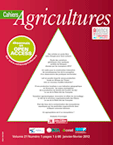The utilization of botanical dusts in the control of foodstuff storage insect pests in Kivu (Democratic Republic of Congo)
Keywords
phytosanitary protectionAbstract
In central Africa and in Kivu (DR Congo), 10-60% (beans, maize and sorghum) of weight loss are observed annually in foodstuff storages. These losses are mainly caused by a bruchid beetle (Acanthoscelides obtectus) and a weevil (Sitophilus oryzae). Pesticides are largely used to control these storage pests. However, synthetic insecticides are expensive and their use is very limited in developing countries. All the studies are now oriented towards the utilization of natural products for the control of crop pests. A laboratory trial was carried out using the powder from local plants. Setting up a random design, we evaluated the efficiency of 3 different plants powders (Maesa lanceolata, Agava americana, Tagetes minuta) in the protection of beans, maize, and sorghum against storage pests. The following doses were tested: 0, 10, 20, 30 g/kg of foodstuff seeds. The powders were mixed with grain samples that were then artificially infested by the storage insect pests (the bruchid or the weevil). The plant powder (30 g/kg) of M. lanceolata significantly reduced the emergence of the bruchids during the storage of the beans. The average number of emerged bruchids was of 1.1 against 73 (untreated) control. Five couples of A. obtectus or ten couples of S. oryzae were released in each experimental unit (beans and cereal seeds, respectively) during the set up of the trial. The average weight loss in the storage varied between 0.001% and 0.003% against 33.7% (untreated control) with the M. lanceolata plant powder. The plant powder (30 g/kg grains) of A. americana, reduced the weight loss and the emergence of bruchids in bean storages. The reduction was in the range of 0.05-1.6%, 3-5 respectively, while in the untreated control a weight loss of 53 to 87% and an emergence of 10 to 61 bruchids were recorded. None of the botanical we used, whatever the dose utilized, protected sorghum grain against weevil (S. oryzae) attacks in the storage. The weight loss was about 56-85% during the trial with no significant difference between treated and untreated seeds. The number of emerged weevils varied between 91 and 199 in all the experimental units. Only M. lanceolata has a high level of efficacy against bruchid beetles. It may be a potential alternative to expensive synthetic insecticides for the protection of stored foodstuffs against bruchids attacks.Downloads
Published
2003-01-01
How to Cite
Bin Mushambanyi, T. M. . (2003). The utilization of botanical dusts in the control of foodstuff storage insect pests in Kivu (Democratic Republic of Congo). Cahiers Agricultures, 12(1), 23–31. Retrieved from https://revues.cirad.fr/index.php/cahiers-agricultures/article/view/30373
Issue
Section
Articles

